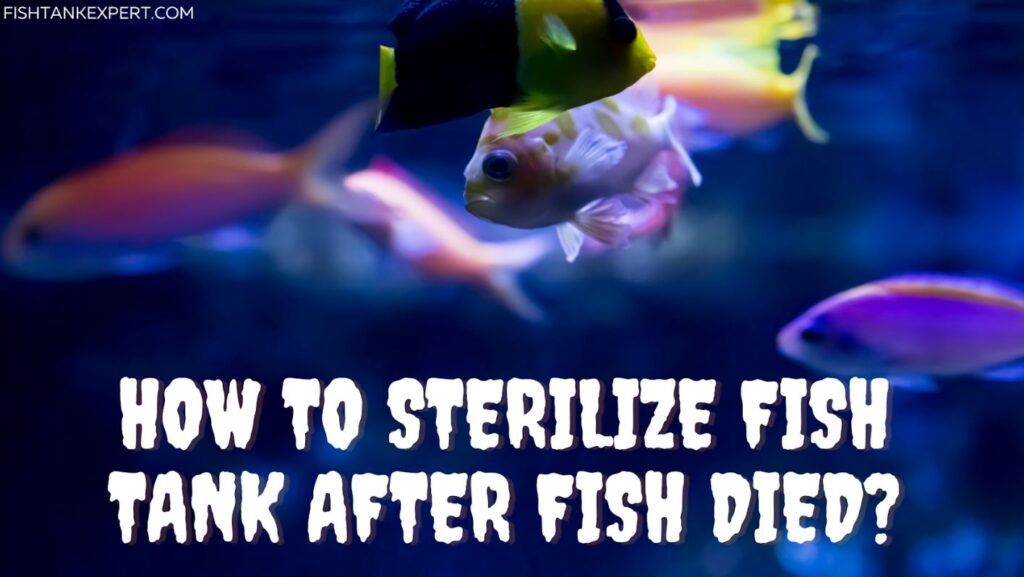Sterilizing your tank is an excellent way to remove bacteria, particularly if one of your fish has died or the tank has been in storage.
If you want to clean a dirty tank quickly and effectively, vinegar and water is an excellent option. If the tank has had sick or dead fish, however, a stronger solution might be required. My favorite is the Tetra WaterClarifier Treatment Solution.
If your tank keeps getting dirty, you should check out our article Why Does My Fish Tank Get Dirty So Fast?
How To Sterilize A Fish Tank After Fish Died?
For first-timers, cleaning a fish tank may be overwhelming, so here are six easy-to-remember steps to follow in order to sterilize a fish tank after a fish has died.
#1 – Extract 20-30% of the water from your aquarium
That should be self-evident. Draining the tank would be simple if you have a high-end filtering system. If not, a dipper or a hose would suffice to drain the water.
#2 – Remove the fish from the bowl
It will be easier to remove your fish once there is less water left in the tank. Fill a basin with clean water and place them in it (fresh or salt, depending on their needs). Only make sure they don’t jump out. If you have jumpers, you may want to cover it.
#3 – Remove the rocks, plants, and other decorations so that you can clean them individually
It’s now time to clean your fish tank individually by removing all of the aquarium decorations. If your aquarium contains artificial plants, you can remove them and clean them as well. Chemicals should not be used to clean these because they are difficult to remove. The easiest thing to do is to simply wash them off with water and scrub them with a clean tooth brush.
#4 – Scrub the insides of the tank
You can begin scrubbing the walls of your fish tank until it is clear of several obstructions. If you haven’t washed your fish tank in a while, there will almost certainly be algae on the walls. Using an algae wiper, scrub them clean. Algae wipers can be found in fish supply shops. No matter how difficult it is to extract the soil, do not use chemicals to clean your tank.
#5 – Wash the gravel
Next, when the filter system is turned on, wash the gravel with your hands. Make an effort to thoroughly clean it. Remember that the bottom of your tank is where your fish’s poop goes, so there’s bound to be a lot of bacteria and algae there. You can use Natural Rapport Aquarium Gravel Cleaner to extensively clean the gravel.
#6 – Disconnect your filtering system and clean it under running water
You should turn off your filtering machine after you’ve washed the gravel. It’s best to clean one filter at a time if you have two in your tank. The water balance in your fish tank can be ruined by too much cleanliness.
You can re-start your filtering system after cleaning it. It might take a couple of hours for the water to be clean again, depending on how much water is left in your tank. Fill your tank with the right water for your fish until the water appears to be clear.
You can reassemble your fish tank until all of the parts are clean and free of any green, mossy material. Before you put your fish back in their aquarium, make sure your filter system is back in place and functioning well with the new water you’ve added.
As you can see, sterilizing a fish tank is simple if you know what to do, when to do it, and how. Yes, it takes a long time and there are many tasks to be completed. Your fish, on the other hand, will undoubtedly enjoy your efforts and live happily in their clean aquarium.
Closing
Is there a beautiful aquarium in your living room? Do you believe it has been soiled but are unsure how to clean it? A clean fish tank provides a healthy place for the fish to live in; when the water becomes green and full of algae, the fish may become infected with a variety of diseases and eventually die.
If you have a small to medium-sized fish tank, you can clean it once a month to ensure that the fish can live in a healthy environment. Water is the fish’s respiratory medium, and if the water is dirty, the bacteria in it will cause a lot of infection in the fish’s respiratory system.
